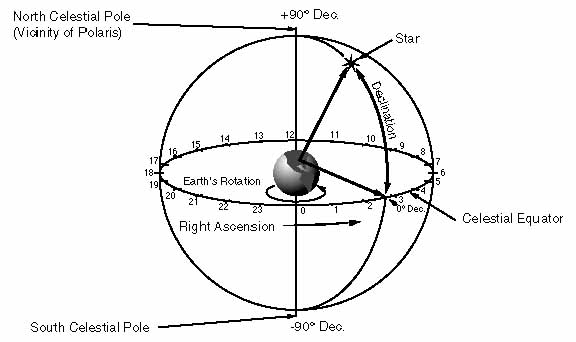| Department of Physics | University of Durham | Level One |
Astronomers use a system similar to latitude and longitude to define the positions of objects in the sky. This co-ordinate system is defined on the so-called celestial sphere which is an imaginary sphere of immense radius. This co-ordinate system mimics latitude and longitude in the sense that the Earth's axis defines the celestial poles and the projection of the Earth's equator defines the celestial equator. While the angle up from the celestial equator, the equivalent to latitude, is an object's Declination (Dec), the Right Ascension (RA), equivalent to longitude, is defined from a fixed direction in space. Just as the position of Durham could be given as longitude 1.34 degrees, latitude 54.42 degrees, the position of a star like Arcturus could be given as RA 213.9 degrees, Dec 19.2 degrees.

There are however two subtleties in the RA/Dec co-ordinate system. First, for historical reasons, RA is measured in units of time (hours, minutes, seconds) while Dec is measured in the usual units of angular measurement (degrees, minutes, seconds), i.e. Arcturus' position is RA: 14 hours 15 minutes 34.5 seconds and Dec: 19 degrees 11 minutes 31 seconds. Note that one second of RA (a second of time) is a much larger unit than one second of Dec (an arcsecond). In fact it is straightforward to show that:
RA difference [arcsecond] = RA difference [seconds of time] x 15 cos(Dec)
Secondly, again for historical reasons, RA is defined to increase from West to East, i.e. right to left, on the celestial sphere when looking towards the South from northern latitudes. Images are usually displayed with RA running from right to left and Dec from bottom to top, i.e. as the sky is seen by a northern latitudes observer looking South. This convention is used for the images in this experiment.
It is unnecessary for this experiment to discuss this co-ordinate system further. However if you are interested in investigating this further look at the SkyView programme on the PC after completion of the experiment.
![]()
This page is maintained by jrl. Last updated: 1998-Jun-06